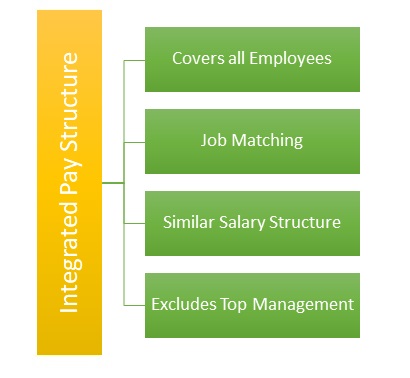- Business Concepts ›
- Human Resources (HR) ›
- Integrated Pay Structure
Integrated Pay Structure
Definition, Importance & Example
This article covers meaning & overview of Integrated Pay Structure from HRM perspective.
What is meant by Integrated Pay Structure?
Integrated Pay Structure is a salary structure which covers the complete company. In integrated pay structure there is a single salary structure for all employees like managers, sales, admin staff, technical staff etc. The directors and senior management are not a part of this integrated pay structure.
Earlier organizations used to have strict levels of organizational hierarchy with distinct pay differences, on the level of hierarchy. Now the organizations have started becoming flatter. The pay grades are larger, and the ranges are wider with no such mid points. Also the number of pay grades are lesser now. Earlier salary structure was fully based on the level of performance and the fixed and variable component was totally based upon it.
Now the fixed component remains at its place, and the variable component constitutes of various allowances lie that of house allowances, travel allowances etc. The pay structures are changing as the working culture of the organizations are undergoing a massive revolution, where by the pay structures need to be aligned so as to retain employees.
Importance of Integrated Pay Structure
As we all know that organization structure forms the basis of all the other strategies and plans required for an organization to accomplish goals, employee engagement and motivation also forms one of the most important basis for a strategy and plan defined for an organization to work out well. As said, pay structures are done by a process of job evaluation and then categorized according to the market demand. Now the structures are so that it almost does not vary much with the market demand. This highlights the importance of integrated pay structure, more than the distinction on the basis of job evaluation pints which are pure result of job analysis, only a part of the salary is fixed on the basis of that, and other all components of the pay structures are based on performance, incentives, and many more allowances.
Integrated pay structures motivate the employees to work in a collaborate manner without having differences in mind and heart about the level of positions they are holding and what they getting paid for the same. This increases the team work in an organization and helps to achieve a regulated work culture in the organization. Integrated pay structure peps up the spirit of the employees to work more.

Advantages & Disadvantages of Integrated Pay Structure
Some advantages of integrated pay structure are:
1. Employee engagement.
2. Motivated employees.
3. Better team management.
4. Less attrition rates
Certain disadvantages are:
1. Employees’ need for more recognition.
2. Equal treatment may hurt the top positioned employees.
Example of Integrated Pay Structure
A simple example, for this concept would be – let us consider jobs with distinct job evaluation points, this simply means the job analysis has been done and on the basis of point method, the point shave been given. But in an organization the number of grades are less, this means there is a wide range of points being put in the same pay scale. Here the payment starts varying on the basis of the variable component, which includes performance based pays along with the various allowances. The person gets the fixed payment more or less the same, and all other variable components increase his motivation to work for the company.
Hence, this concludes the definition of Integrated Pay Structure along with its overview.
This article has been researched & authored by the Business Concepts Team which comprises of MBA students, management professionals, and industry experts. It has been reviewed & published by the MBA Skool Team. The content on MBA Skool has been created for educational & academic purpose only.
Browse the definition and meaning of more similar terms. The Management Dictionary covers over 1800 business concepts from 5 categories.
Continue Reading:
What is MBA Skool?About Us
MBA Skool is a Knowledge Resource for Management Students, Aspirants & Professionals.
Business Courses
Quizzes & Skills
Quizzes test your expertise in business and Skill tests evaluate your management traits
Related Content
All Business Sections
Write for Us